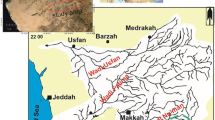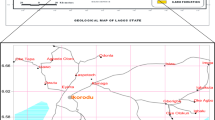Abstract
Geomorphological mapping through satellite remote sensing coupled with geophysical electrical resistivity survey (vertical electrical sounding) gives very useful information about spatial and depth-wise variation of aquifer’s material, respectively. The present study area broadly falls between the Ganga river and Kharagpur hills (a northern limit of Chotanagpur plateau). These hills are highly folded and consist of quartzites and phyllites of Precambrian age group In the study area, cover material above the basement is the product of weathering, colluvial and fluvial processes of different ages. Geomorphologically, study area has been categorised into different classes i.e. denudo-structural hill, buried pediment, younger alluvial plain, recent flood plain and older alluvial plain. Broadly these classes represent the general ground-water prospects, but in detail, possibility of variation in ground-water prospects cannot be ruled out. In alluvial plain (younger/older) main target for ground-water exploration is sandy horizon. Similarly in buried pediment the main target is coarse-grained weathered material with fractured basement, not the total general thickness of cover material on the basement. In the present paper, authors have tried to analyse the spatial distribution of geomorphic classes and depth-wise variation of aquifer material within the same class for determining the target horizon for further detailed investigation, using remote sensing and electrical sounding.
Similar content being viewed by others
References
Kumar Ashok (1989). Is hydrogeomorphic mapping in hard rock area useful for groundwater prospects determination - A resistivity survey analysis,Proceedings of Fifteenth Annual Convention and Seminar on Exploration Geophysicist, December 11–13, Madras.
Mishra D, Singh Hira and Rao MBS (1990). Remote Sensing and Geoelectrical Investigation for Groundwater in South Central part of Lalitpur District, Uttar Pradesh,Jour. Assoc. Expl. Geophys., Vol. XI, No. 1, 17–28.
Rai S S and Dayal R (1971). Geology and Geohydrology of the South Monghyr Region, Bhagalpur Division, Bihar,Jour Soil and Water Conservation in India, Vol. 19, No. 4, pp 83–102.
Roy R K, Chattopadhyay G S and Bisaria B K (1987). A Geoscientific Appraisal of Munger District, Bihar for Rural Development,GSI Bulletin Series ‘B’ No. 49.
Sinha S K and Nath S (1987). Hydrological conditions, Groundwater Resource and Development Potential of Munger District, Bihar,CGWB Technical Report: Series ‘D’ No. 53.
Sinha B K, Kumar Ashok, Srivastava Deepak and Srivastava Sanjay Kumar (1990). Integrated approach for demarcating the fracture zone for well site location - A case study near Gumla and Lohardaga, Bihar,Jour. Ind. Soc. Rem. Sens., Vol. 18, No.3, pp. 1–8.
Sinha B K, Kumar Ashok and Srivastava Deepak (1990).Report on Groundwater Investigation for Well Siting in Ranchi District, Bihar,Unpublished BIRSAC Report,Vol.I.
Zohdy A A R (1989). A New Method for Automatic Interpretation of Schlumberger and Wenner Sounding Curves.Geophysics, Vol. 54, No. 2, pp 245–253.
Author information
Authors and Affiliations
About this article
Cite this article
Kumar, A., Srivastava, S.K. Geomorphological units, their geohydrological characteristic and vertical electrical sounding response near Munger, Bihar. J Indian Soc Remote Sens 19, 205–215 (1991). https://doi.org/10.1007/BF03030772
Issue Date:
DOI: https://doi.org/10.1007/BF03030772




